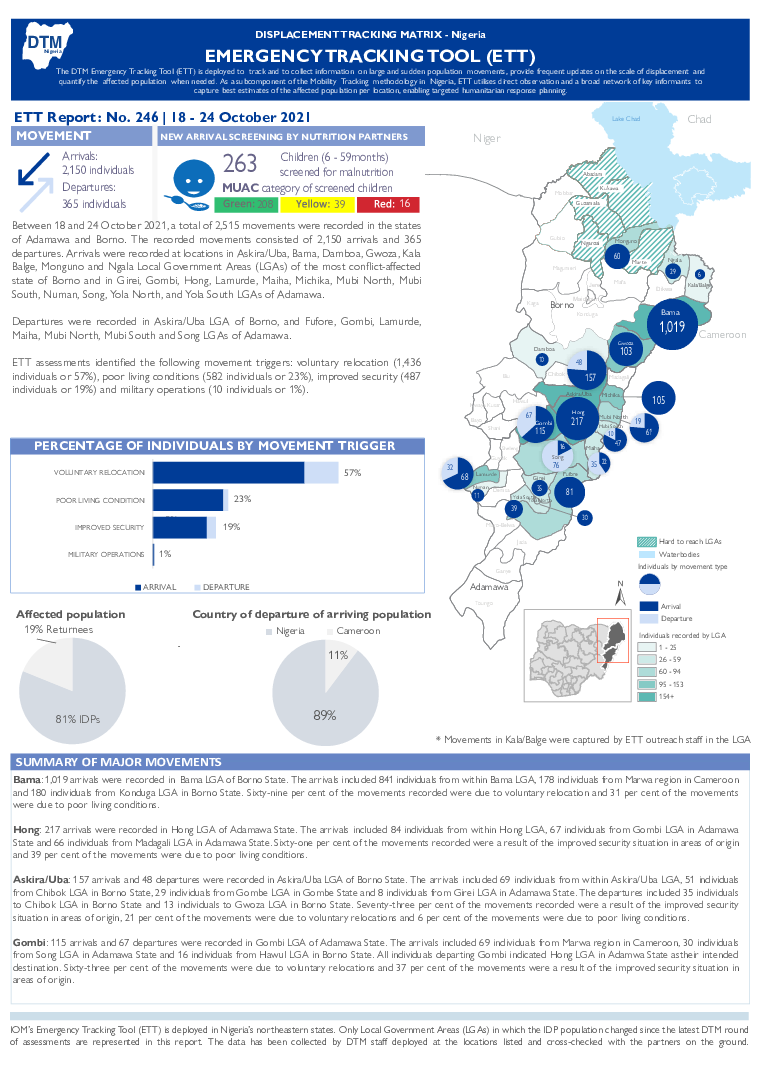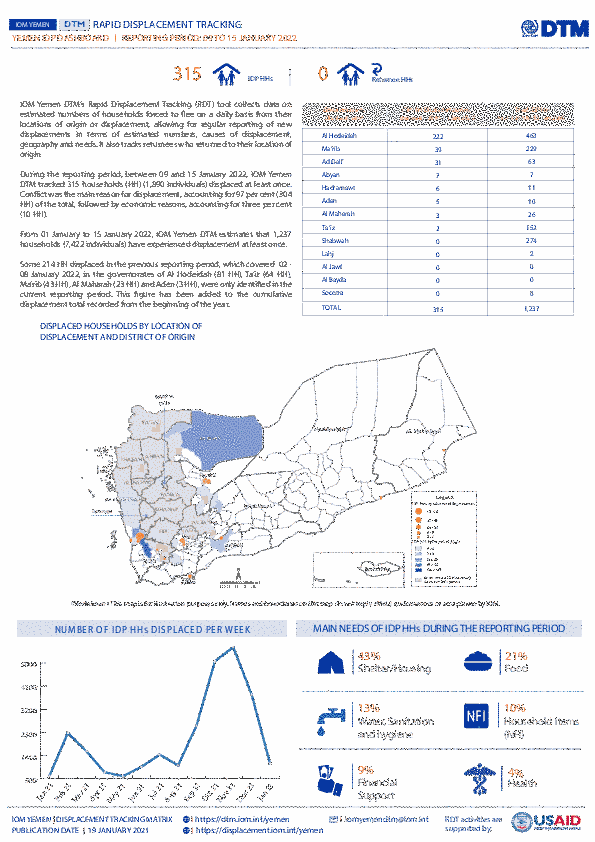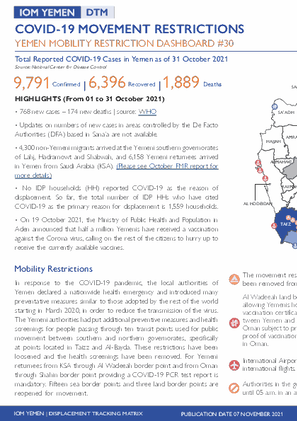-
Countries
-
Data and Analysis
-
Special Focus
-
Crisis Responses

Contact
DTM Nigeria, AllUsersInDTMNigeria@iom.int
Language
English
Location
Nigeria
Period Covered
Oct 18 2021
Oct 24 2021
Activity
- Event Tracking
- Mobility Tracking
Between 18 and 24 October 2021, a total of 2,515 movements were recorded in the states of Adamawa and Borno. The recorded movements consisted of 2,150 arrivals and 365 departures. Arrivals were recorded at locations in Askira/Uba, Bama, Damboa, Gwoza, Kala Balge, Monguno and Ngala Local Government Areas (LGAs) of the most conflict-affected state of Borno and in Girei, Gombi, Hong, Lamurde, Maiha, Michika, Mubi North, Mubi South, Numan, Song, Yola North, and Yola South LGAs of Adamawa.
Departures were recorded in Askira/Uba LGA of Borno, and Fufore, Gombi, Lamurde, Maiha, Mubi North, Mubi South and Song LGAs of Adamawa.
ETT assessments identified the following movement triggers: voluntary relocation (1,436 individuals or 57%), poor living conditions (582 individuals or 23%), improved security (487 individuals or 19%) and military operations (10 individuals or 1%).

Contact
DTM Nigeria, AllUsersInDTMNigeria@iom.int
Language
English
Location
Nigeria
Period Covered
Oct 11 2021
Oct 17 2021
Activity
- Event Tracking
- Mobility Tracking
Between 11 and 17 October 2021, a total of 3,530 movements were recorded in the states of Adamawa and Borno. The recorded movements consisted of 2,910 arrivals and 620 departures. Arrivals were recorded at locations in Askira/Uba, Bama, Biu, Damboa, Gwoza, Hawul and Ngala Local Government Areas (LGAs) of the most conflict-affected state of Borno and in Fufore, Girei, Gombi, Hong, Lamurde, Maiha, Michika, Mubi North, Mubi South, Numan, Yola North, and Yola South LGAs of Adamawa.
Departures were recorded in Askira/Uba LGA of Borno, and Demsa, Fufore, Girei, Hong, Madagali, Maiha, Mubi North, Mubi South, Song, and Yola South LGAs of Adamawa.
ETT assessments identified the following movement triggers: poor living conditions (1,796 individuals or 51%), voluntary relocation (1,076 individuals or 30%), improved security (364 individuals or 10%), conflict/attack (177 individuals or 5%), seasonal farming (103 individuals or 3%) and military operations (14 individuals or 1%).
Contact
DTM Yemen, iomyemendtm@iom.int
Location
Yemen
Activity
- Event Tracking
- Mobility Tracking
Period Covered
Jan 09 2022 -Jan 15 2022
From 01 January 2022 to 15 January 2022, IOM Yemen DTM estimates that 1,237 households (HH) (7,422 Individuals) have experienced displacement at least once.
Since the beginning of 2022, DTM also identified 004 displaced households who left their locations of displacement and either moved back to their place of origin or another location.
Between 09 and 15 January 2022, IOM Yemen DTM tracked 315 households (1,890 individuals) displaced at least once. The top three governorates and districts where people moved into/within are:
• Al Hodeidah (222 HH) – Hays (210 HH), Al Khukhah (12 HH) districts. Most displacements in the governorate originated from Al Hodeidah and Taiz.
• Marib (39 HH) – Marib City (21 HH), Marib (18 HH) districts. Most displacements in the governorate originated from Al Jawf and Marib.
• Ad Dali (31 HH) – Ad Dali (20 HH), Qatabah (8 HH), Al Hasayn (3 HH) districts. Most displacements in the governorate originated from Ad Dali and Al Hodeidah.
Most displacements resulted from the increased conflict in the following governorates and districts.
• Al Hodeidah (155 HH) – Hays (122 HH), Al Jarrahi (14 HH), Jabal Ras (5 HH) districts.
• Taiz (84 HH) – Maqbanah (82 HH), Al Mawasit (1 HH), Al Qahirah (1 HH) districts.
• Ad Dali (22 HH) – Qatabah (18 HH), Al Husha (3 HH), Damt (1 HH) districts.
Population Groups
Survey Methodology
Unit of Analysis Or Observation
Type of Survey or Assessment
Keywords
Geographical Scope
Administrative boundaries with available data
The current dataset covers the following administrative boundaries

Contact
DTM Yemen, iomyemendtm@iom.int
Language
English
Location
Yemen
Period Covered
Jan 09 2022
Jan 15 2022
Activity
- Rapid Emergency Registration
- Mobility Tracking
IOM Yemen DTM’s Rapid Displacement Tracking (RDT) tool collects data on estimated numbers of households forced to flee on a daily basis from their locations of origin or displacement, allowing for regular reporting of new displacements in terms of estimated numbers, geography, and needs. It also tracks Returnees who returned to their location of origin.
From 01 January 2022 to 15 January 2022, IOM Yemen DTM estimates that 1,237 households (HH) (7,422 Individuals) have experienced displacement at least once.
Since the beginning of 2022, DTM also identified 004 displaced households who left their locations of displacement and either moved back to their place of origin or another location.
Between 09 and 15 January 2022, IOM Yemen DTM tracked 315 households (1,890 individuals) displaced at least once. The top three governorates and districts where people moved into/within are:
- Al Hodeidah (222 HH) – Hays (210 HH), Al Khukhah (12 HH) districts. Most displacements in the governorate originated from Al Hodeidah and Taiz.
- Marib (39 HH) – Marib City (21 HH), Marib (18 HH) districts. Most displacements in the governorate originated from Al Jawf and Marib.
- Ad Dali (31 HH) – Ad Dali (20 HH), Qatabah (8 HH), Al Hasayn (3 HH) districts. Most displacements in the governorate originated from Ad Dali and Al Hodeidah.
Most displacements resulted from the increased conflict in the following governorates and districts.
- Al Hodeidah (155 HH) – Hays (122 HH), Al Jarrahi (14 HH), Jabal Ras (5 HH) districts.
- Taiz (84 HH) – Maqbanah (82 HH), Al Mawasit (1 HH), Al Qahirah (1 HH) districts.
- Ad Dali (22 HH) – Qatabah (18 HH), Al Husha (3 HH), Damt (1 HH) districts.

Contact
DTM Sudan; dtmsudan@iom.int
Language
English
Location
Sudan
Snapshot Date
Jan 12 2022
Activity
- Mobility Tracking
- Event Tracking
The DTM Emergency Event Tracking (EET) is deployed to track sudden displacement and population movements, provide more frequent updates on the scale of displacement, and quantify the affected population when needed. As a subcomponent of the new Mobility Tracking methodology in Sudan (Round Three), and activated on a need basis, EET utilises a broad network of key informants to capture best estimates of the affected population presence per location – a useful tool for humanitarian response planning and design.

Contact
DTM Support — iomdrcdtm@iom.int
Language
French
Location
Democratic Republic of the Congo
Period Covered
Aug 03 2021
Aug 23 2021
Activity
- Event Tracking
- Mobility Tracking
- Baseline Assessment
Au cours de ce sixième cycle d’évaluation couvrant le mois d’août 2021, les évaluations DTM ont permis de dénombrer 1 479 709 Personnes Déplacées Internes (PDIs) résidant dans des familles d’accueil (84% du total) et 81 447 personnes déplacées vivant dans 43 sites spontanés et centres collectifs1 dans la province (4% du total) (F5B). À cela s’ajoutent les 203 938 PDIs (12%) dans les 50 sites couverts par le mécanisme CCCM2 . Il est estimé à 1.765.094 personnes le nombre total de PDIs dans la province, soit environ 31% de la population3 totale de l’Ituri. Ce qui est comparable aux 1 706 705 personnes en situation de déplacement lors de la dernière évaluation conduite en avril 2021.

Contact
DTM Pakistan, iomisbdtmremapteam@iom.int
Language
English
Location
Pakistan
Period Covered
Dec 19 2021
Dec 31 2021
Activity
- Flow Monitoring
IOM Pakistan collects data on the outflows of undocumented Afghan migrants at the Torkham and Chaman border crossing points in an effort to better understand the migration movements of undocumented Afghan migrants returning to Afghanistan from Pakistan. This exercise is part of the European Union funded project “Displacement Tracking Matrix Regional Evidence for Migration Analysis and Policy (DTM REMAP)”.
From 19 December to 31 December 2021, 2,623 undocumented Afghan migrants returned to Afghanistan, including 227 through the Torkham border point and 2,396 through the Chaman border point. During the reporting period, border authorities facilitated the return of 40 individuals due to the lack of legal documentation to remain in Pakistan. Therefore, information concerning these 40 individuals is not included in the report analysis.

Contact
DTM Sudan; dtmsudan@iom.int
Language
English
Location
Sudan
Snapshot Date
Jan 11 2022
Activity
- Mobility Tracking
- Event Tracking
The DTM Emergency Event Tracking (EET) is deployed to track sudden displacement and population movements, provide more frequent updates on the scale of displacement, and quantify the affected population when needed. As a subcomponent of the new Mobility Tracking methodology in Sudan (Round Three), and activated on a need basis, EET utilises a broad network of key informants to capture best estimates of the affected population presence per location – a useful tool for humanitarian response planning and design.
Jan 18 2022
Print

Contact
DTM Yemen, iomyemendtm@iom.int
Language
English
Location
Yemen
Period Covered
Oct 01 2021
Oct 31 2021
Activity
- Points of Entry (PoE)
HIGHLIGHTS (From 01 to 31 October 2021)
• 768 new cases – 174 new deaths | source: WHO
• Updates on numbers of new cases in areas controlled by the De Facto Authorities (DFA) based in Sana’a are not available.
• 4,300 non-Yemeni migrants arrived at the Yemeni southern governorates of Lahj, Hadramowt and Shabwah, and 6,158 Yemeni returnees arrived in Yemen from Saudi Arabia (KSA). (Please see October FMR report for more details)
• No IDP households (HH) reported COVID-19 as the reason of displacement. So far, the total number of IDP HHs who have cited
COVID-19 as the primary reason for displacement is 1,559 households.
• On 19 October 2021, the Ministry of Public Health and Population in Aden announced that half a million Yemenis have received a vaccination against the Corona virus, calling on the rest of the citizens to hurry up to receive the currently available vaccines.
